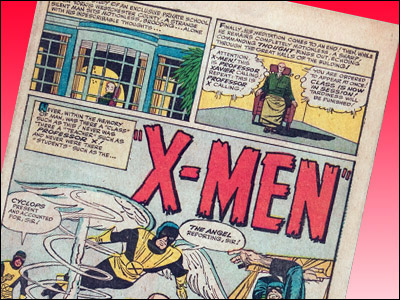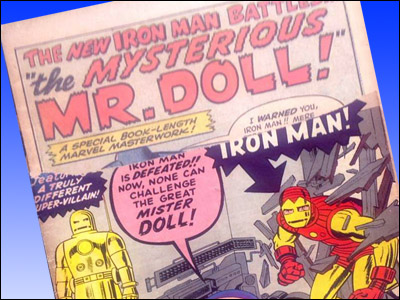Brian Dreger, who sends me some of the best questions I answer here, wants to know…
You must know something about this: As a kid in Ohio we had this store that was (in my memory) like a cheap version of Sears (I know, I know…Sears is like a cheap version of Sears — rimshot!), and in the entrance way there was a machine that sold comics. It was tall (and I think it could spin around so that you could view everything in stock), and the comics were in plastic bags (several to a bag) but you couldn't look through them unless you bought a pack.
The weird thing was that they all had no covers. Was this some way to resell old comics that had poor sales? Were the publishers behind it all? Why no covers? If anyone knows, you do!
I sort of know…I think. Before the advent of something called "the direct market," most comic books were sold like any other magazines, which was on a returnable basis. Let's say you ran a newsstand. You got your magazines from a local distributor who, in turn, got them from a national distributor who got them from various publishers. (I am very much simplifying this whole process down here.)
The publisher got paid only for what was actually sold to consumers. If they printed 250,000 copies of an issue of Hypothetical Example Comics and 150,000 were ultimately purchased, the publisher would only get paid for that 150,000.
You, the dealer, would return whatever you didn't sell…or didn't want to. In most areas, you could return as many as you wanted at any time. If you got 25 copies of the new issue of Hypothetical Example and your rack was crowded or you'd notice that very few people bought that comic, you might throw ten of them in your "returns" box right away and never put them out for sale. You could return all of them. If copies of anything on that rack got dogeared or torn, as many did, you might also toss them into the "returns" box. As newer comics came in, you might throw some that had been on sale for a few weeks into that "returns" box.
And you certainly would return any unsold issues of last month's Hypothetical Example Comics when the new issue of Hypothetical Example Comics came in. A fellow who worked at the local distributor in Los Angeles told me in 1970 that he thought the average "on sale" period for a comic book was around twelve days.

Quick, possibly interesting aside: Once upon a time, publishers tried to avoid putting #1 on a new comic. DC would sometimes just leave the number off or try to start with a higher number. When they revived The Flash in 1958, the numbering started with #105, picking up where Flash Comics (starring a previous character with the same name and power) had left off when it was canceled in 1949. That was because of a questionable theory that newsstand dealers sometimes just sent back #1 issues without displaying them. Nowadays, of course, publishers love to put out and ballyhoo first issues because buyers often grab them up in bulk.
Back to our story: You, the retailer, would pay only for what you didn't return. Then between the local distributor, the national distributor, the publisher and maybe a couple of intermediaries and other parties, one of five things would happen to that 100,000 unsold comics…
- They would wind up in some warehouse somewhere in the publisher's control and that publisher (or someone) would figure out how to sell them overseas…but now and then, publishers tried repackaging them — perhaps in plastic bags — and selling them through discount outlets. There wasn't a lot of money to be made no matter what they did because someone had to be paid to sort through all those returns and pull out the ones in decent condition, which by this time might be a small percentage. Bagging and redistribution cost money too so the bulk of the returns wound up being pulped and the paper was recycled in some way.
- Since it cost money to ship comics back to that warehouse somewhere, some local distributors didn't. As per an agreement with their national distributors, they would have a bunch of paid-as-little-as-possible workers rip the covers off. The rest of the comic would be pulped locally and the covers would be shipped back to the national distributor as proof that the comics had not been sold.
- Some local distributors would just strip the top third of the cover off and send those back. This option had all the same problems. Someone had to deface the comics. They had to be counted on both ends of the transaction…though sometimes, they would just weigh the crates of covers or partial covers. This was not the most accurate way to do things.
- More and more through the sixties, many went to the "affidavit" method. The local distributor would arrange for all the returns to be pulped and they would just inform others up the chain of how many they'd sold (again, sometimes by weight) and how many they'd pulped, and the national distributor and the publisher would just have to take their word for it, relying perhaps on spot checks.
Obviously, all these systems had enormous problems of waste. If the publisher of Hypothetical Example Comics managed a 40% sell-through (and some comics didn't even do that well) that would mean the only compensation that publisher received for 60% of what it had paid to produce and print was the tiny amount it might (might!) receive for the value of what was pulped and recycled.
Obviously too, there were also endless opportunities for fraud and lying and theft and even sloppy, inaccurate bookkeeping. Just reading the above, you can probably think of a dozen ways to cheat that system. One way might involve those comics that had all or part of their covers stripped. The rest of the comic was supposed to be pulped but through collusion or bribery or maybe even if you were the local distributor and willing to cheat, you might make bundles out of them and find a way to sell them.

I said there were five things that might happen to unsold comic books back then. We are now discussing #5.
In the early sixties when I was buying comic books for a nickel each (six for a quarter) at used bookstores, there was a shop in Downtown Los Angeles called Everybody's Books. You never saw so many used books and magazines in your life. And out front to attract passing customers, they had a little display of bundled comics. It was ten coverless comics, tied up with twine such that you could only see the top comic.
The bundles were 40 cents each and I took a gamble once and bought five of them, each of which displayed on top a coverless comic I did not own. I got the bundles home, untied them and found that I had three bundles with the exact same comics in them, just in a different order. The two others contained a slightly different mix. The comics were from all different publishers and there were a few overlaps. For instance, each of the five bundles contained a coverless copy of The Brave and the Bold #28 featuring the first appearance of the Justice League of America.
Similar bundles sometimes popped up in discount stores or on newsstands. One year at my elementary school, they had a big Mardi Gras fund raising event with rides and games…and there were vendors selling merchandise. One vendor had bundles of old coverless comics tied in bundles like the ones I later bought at Everybody's Books.
Also, down in San Diego, I once visited — and some friends of mine visited often — a used book shop that had for sale thousands of unbundled comics that were either lacking their covers or lacking the top third of their covers. Scott Shaw! was a customer there and he says it was called Lanning's Books and it was on Broadway near the library.

What you found in that machine, Brian Dreger, was obviously just another way someone managed to get their mitts on comics that were meant to be pulped and to sell them another way. If they'd all been from the same publisher, I might suspect the publisher had been part of the deal. If they weren't, the publishers probably never knew about it…or knew and just couldn't stop it. In some cases, it might have meant suing distributors and if you want to stay in business, that's usually not a wise thing to do…sue your distributor.
In the mid-to-late seventies, Direct Market Distribution began to nudge that system aside. With Direct Market, retailers (mainly comic book shops and other specialty outlets) order comics in advance. The publisher prints and the distributor sends out the proper amount of copies to fill those orders. There are no returns, very little spoilage. The retailers pay for all they receive and if they don't sell — or don't sell rapidly — then it's the retailer's problem. Much neater.
If you scour the Internet, you can probably find many articles about how the Direct Sales Market came to be and most will give props, though perhaps not enough of them, to a gent named Phil Seuling. But others deserve credit, as well. Among the many things to note about the Direct Sales Market is that, first of all, it saved the industry. The old system was even failing even in honest ways and was in dire need of replacement.
Also, the new system made new publishers possible. A handful of established publishers no longer had an iron grip on distribution in America, keeping most others out and perhaps sabotaging the few that did get in. Anyone remember Tower Comics? Lightning? Gil Kane's attempt to become a publisher that ended after one issue? The Edgar Rice Burroughs Estate made repeated attempts to become the publisher of comic books starring Tarzan and its other properties. They could not get national distribution.
And the new system made it more possible to pay writers and artists royalties based on sales of the comics they produced. One of the many excuses publishers used to use as to why they didn't went something like this: "We can't pay you royalties because we can't give you an honest count. We don't get an honest count ourselves!" There was some truth to that although the larger truth was that they just didn't wanna share. I do not think very many people who today do great comics would be in the field at all had that not changed.
There have been other ramifications, most of them for the better…but that's a long-enough answer to your brief question, Brian. Next time, ask a long question and I'll give you a brief answer. Thanks.
